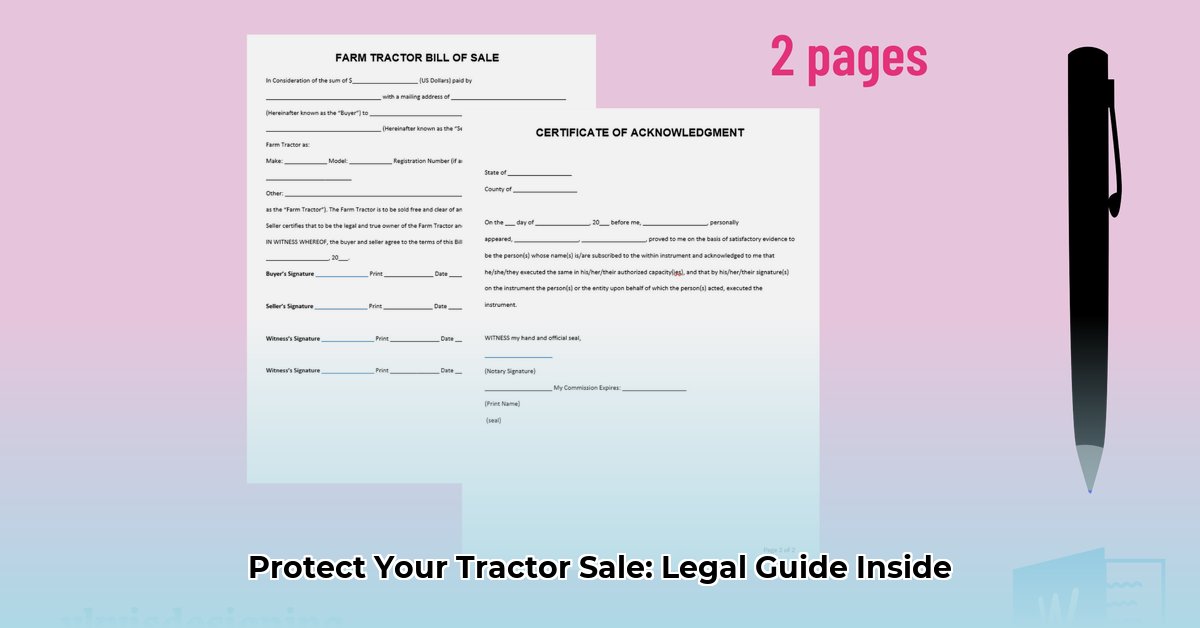
Selling a used tractor? A legally sound transaction requires more than a handshake. This guide helps farmers navigate the process, from creating a comprehensive bill of sale to legally transferring ownership. Understanding these steps protects both the buyer and seller, ensuring a fair and transparent exchange.
Understanding the Tractor Bill of Sale
A tractor bill of sale is a legally binding contract documenting the sale and transfer of ownership. It's crucial proof of ownership and protects against future disputes regarding the tractor's condition, price, or payment arrangements. Without a properly executed bill of sale, resolving ownership issues can become extremely difficult and costly. Think of it as your insurance policy for a smooth and trouble-free transaction.
Key Components of a Complete Bill of Sale
A thorough bill of sale leaves no room for ambiguity. Here's what must be included:
Date: The date of the sale (MM/DD/YYYY). This establishes the timeline of the transaction.
Parties Involved: Seller's full legal name and address, and buyer's full legal name and address. Avoid nicknames; use only legally recognized names and complete addresses.
Tractor Specifications: Make, model, year, and—critically—the serial number. This unique identifier prevents confusion with similar models.
Sale Price: The agreed-upon price in clear numerical format ($XXXX.XX). Ambiguity here can lead to significant disputes.
Payment Terms: Detail the payment method (cash, certified check, cashier's check, financing) and schedule (single payment or installments, including deadlines). Specificity is key to avoiding misunderstandings.
Warranties (Optional but Recommended): Clearly state any warranties or guarantees offered. If none, explicitly state "as is" to manage liability. A written warranty detailing specific coverage, duration, and limitations protects both parties.
Signatures: Both buyer and seller must sign and date the document. This signifies mutual agreement and makes it legally binding.
| Item | Description | Importance |
|---|---|---|
| Date | The date the tractor ownership changes hands (MM/DD/YYYY). | Establishes a clear timeline, preventing later disputes about when the sale occurred. |
| Parties Involved | Full legal names and complete addresses of both buyer and seller. | Essential for legal identification and enforcement should disputes arise. |
| Tractor Details | Make, model, year, and, most importantly, the serial number. | Uniquely identifies the tractor, preventing confusion and ensuring the correct tractor is sold. |
| Price | The agreed-upon sale price, clearly stated in numerical format ($XXXX.XX). | Forms the financial basis of the agreement. |
| Payment Terms | Payment method (cash, check, financing) and a detailed payment schedule (single payment or installments, with due dates). | Precise details are crucial to avoiding future disagreements. |
| Warranties (Optional) | Clearly defined warranties, or an "as-is" clause specifying that the tractor is sold without warranty (except as stated). | Protects both parties from future disputes about the tractor's condition. |
| Signatures | Legally binding signatures from both buyer and seller, acknowledging the agreement, including the date of signature. | Makes the document legally valid and serves as concrete proof of mutual consent. |
Preparing Your Tractor for Sale
Before listing, prepare your tractor for a smooth sale. This enhances its appeal and commands a better price.
Thorough Cleaning: A clean tractor is more appealing to buyers. Wash it inside and out, paying attention to detail.
Pre-Sale Inspection: Conduct a thorough mechanical inspection yourself or hire a qualified mechanic. Repair any significant issues. This prevents post-sale problems and builds buyer trust.
Gather Documents: Collect the title, owner's manuals, and service records. These add transparency and build buyer confidence.
High-Quality Photos: Take clear pictures showcasing the tractor's condition, highlighting its best features. Show any imperfections honestly.
Marketing Your Tractor Effectively
Choose appropriate marketing channels to reach potential buyers. Options include:
Online Classifieds: Utilize agricultural equipment classifieds websites.
Local Networks: Leverage your farming community network through word-of-mouth.
Auctions: Consider agricultural equipment auctions for broader reach and potential for competitive bidding.
Honesty is crucial. Accurate and detailed descriptions, coupled with realistic photos, attract serious buyers.
Negotiating the Sale
Negotiations are a normal part of the process. Listen to the buyer's concerns, address them honestly, and aim for a mutually beneficial outcome. A fair price protects both parties and minimizes potential post-sale complications. Consider seeking legal guidance if negotiations become complex or contentious.
Legal Considerations
Selling a used tractor involves risks. Disclose known defects upfront. While an "as-is" clause limits liability, understand its implications. Consult a legal professional to fully understand your rights and responsibilities, especially for high-value tractors.
Post-Sale Procedures
After the sale, ensure a proper title transfer. Follow your state's regulations for updating ownership records. This step completes the legal transfer, protecting you from future liability.
Conclusion
A well-prepared bill of sale is essential for successful tractor sales. By following this guide, you'll ensure a legally sound and transparent transaction, protecting both you and the buyer. Remember, when in doubt, consult with a legal professional.
Resources
- Sample Bill of Sale Form (Replace with actual link)
- Your State's DMV Website for Title Transfer Information (Replace with actual link)
- Agricultural Equipment Association (Replace with actual link)
Key Takeaways:
- A well-structured bill of sale is crucial for transferring ownership legally and minimizing future disputes.
- Thoroughly preparing your tractor and honestly representing its condition increases buyer confidence and improves your chances of a successful sale.
- Understanding the legal implications of warranties and liability is important to protect your interests.